The nineteenth century was the great age of exhibitions as industrialisation, colonialism and nationhood led to national and international display and celebration. The hall built for the 1854 exhibition had been outgrown and had fallen into disrepair – The Argus believed that “the present Exhibition-building will be entirely inadequate to contain the contributions, even of Victoria alone.” And so the reserve behind the Melbourne Public Library, open for just 10 years, became the site of the Intercolonial Exhibition of 1866. By this time Melbourne had already hosted 2 exhibitions, and contributed material to international exhibitions in London and Paris – so the colony of Victoria was well versed in creating a show.
George Bindon, spoke in the Victorian parliament, calling for support for the intercolonial exhibition, invoking the positive impacts of the Great Exhibition held in England in 1851:
At the present time, the influence of that Exhibition was felt in almost every branch of manufacturing industry, and he believed that very important results would attend the establishment of intercolonial exhibitions in the Australian colonies. It was extremely desirable that the interchange of thought and communication between the different colonies should be encouraged; that a better knowledge should be diffused of the products of each colony, and that a bond of brotherhood should be promoted amongst them.
The Argus, 13 May 1865, p 5.
Those previous exhibition buildings have not survived – nor those constructed for the 1866 exhibition. Still standing though, are the Royal Exhibition buildings built for the Melbourne International Exhibition of 1880. They have since been the focus of community and collective activities – such as the opening of Australia’s first federal parliament, a venue for the 1956 Olympics, and who remembers sitting an exam under those soaring ceilings? The buildings became a site for public health initiatives – a hospital for the flu epidemic of 1918-20; and 100 years later – for COVID testing and vaccinations.
Only the Ian Potter Queens Hall remains from the buildings of this time. Some of the drawings that we have in our collection of the proposed Great Hall are dated May 1866. Clearly, from that date, construction proceeded at great speed and the exhibition opened on 24 October of the same year.

Longitudinal Section – Great Hall : Elevation – Great Hall [picture], Reed & Barnes, architect, H2010.69/17
The proposed buildings would include
….two large rooms, to be erected in the rear of the present library and connected there with, and two wings, one on the north side, fronting Latrobe Street, and the other on the south side, facing Little Lonsdale Street…each about 220 feet long, and two side wings, extending the full depth of the building. The first room will be divided into a circular vestibule, and two open quadrangles. Access will be given from the vestibule to the quadrangles, and also the second long room designated the great hall.
The visitor, on entering the building from Swanston Street, will pass into the vestibule, and from thence into the quadrangles, the wings, or the great hall, as disposition may dictate; It is proposed to cover the vestibule with a circular dome, lighted from above. When the original design is completed, the vestibule will enclose a staircase from whence access will be obtained from the ground floor to the library, the museum, and the fine arts galleries,’ &c, and the present staircase to the Public Library be removed. The great hall will be spanned by a wagon head roof, lighted with clerestory windows.
Australian news for home readers, 27 Aug 1866, p 11
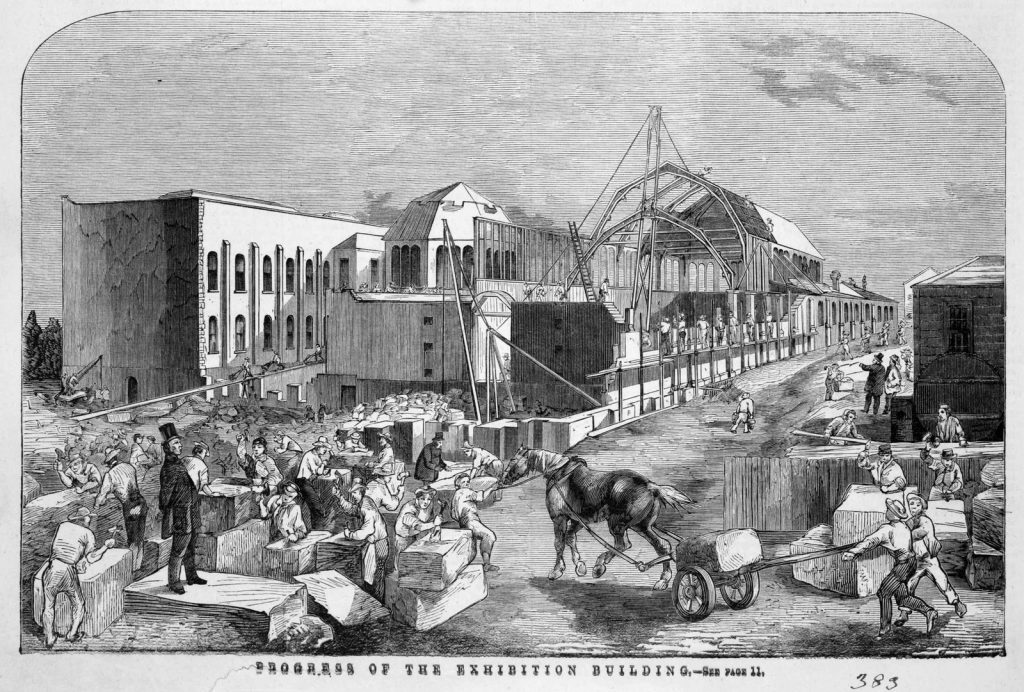
On completion of the buildings, Redmond Barry, library founder, spoke to the workmen, comparing these new buildings to similar in Europe, and celebrating their work:
the highest commendation which need be given as to the excellence of the workmanship is, that it has satisfied the architect, whose duty it has been to certify to the trustees that it is equal to that required by the specification….it strikes me as likely that some of you will look in after years with satisfaction on that Roll, and that your descendants may feel a not unworthy pride in the recollection that you in your day assisted to build this hall.
Address to the workmen delivered by Sir Redmond Barry on Saturday, September 8, A.D. 1866., p 39-40
Launch events included a concert on 16 September and a mayoral ball on 20 September.
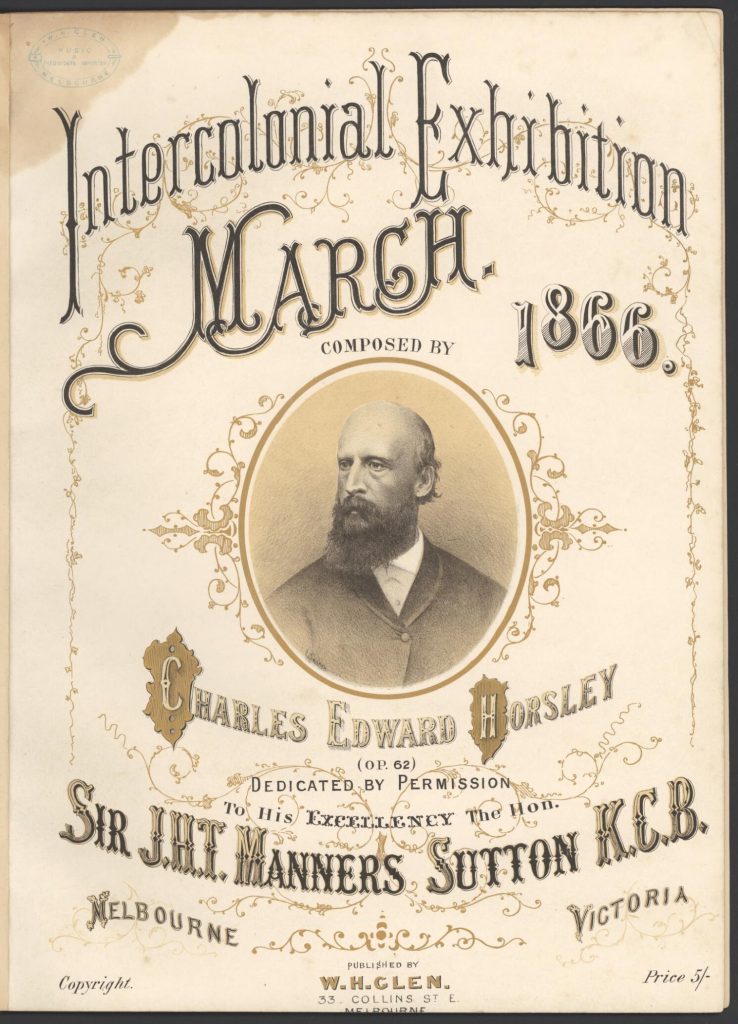
[National Library of Australia digitised item]
Over 1200 people attended the ball – a major talking point was the press dress worn by Matilda Butters, made from printed silk panels, representing Melbourne newspapers.
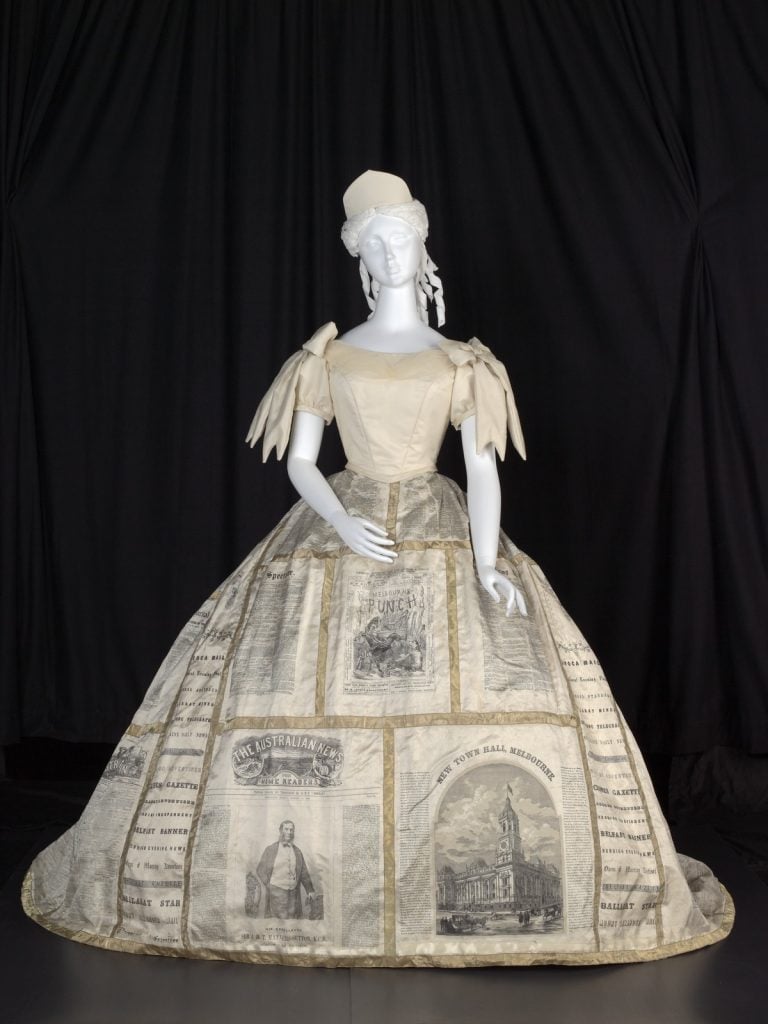
The building starred as well:
a hall incomparably the most spacious, the most artistic in its interior structure, and the most profuse and elaborate in decoration of any yet attempted to be erected on the Australian continent. Indeed, so far does it transcend in these combined respects any hall in the colony that it would be difficult to convey, by mere verbal description, to those who have not seen it, an adequate idea of its extent and beauty.
The Mayor’s fancy dress ball, The Age, 21 September 1866, p 5
Opening on 24 October, with The Age, reported that
…the industrial energies of the people, no longer absorbed in the reckless pursuit of gold, took a new direction, and a spirit of emulation was engendered, calculated to give scope to the skill and enterprise of its artisans and manufacturers. We are indebted to the Hon. Mr Bindon, the present Minister of Justice, for the proposal to hold a series of intercolonial exhibitions of industry. The Parliament of Victoria afforded very generous encouragement to the project ; and the sister colonies, in a spirit of friendly rivalry, were challenged to a competition in a display of the products and manufactures of each, and will be fairly represented at the Exhibition. 1
The exhibition displayed thousands of items from the various colonies, regional centres such as Beechworth, Ballarat and Sandhurst, and internationally from New Zealand, New Caledonia, Mauritius and Dutch Batavia.
The newly built rooms were filled to capacity with diverse displays, the catalogue running to hundreds of pages, recording the creative and industrial outputs of the exhibitors.
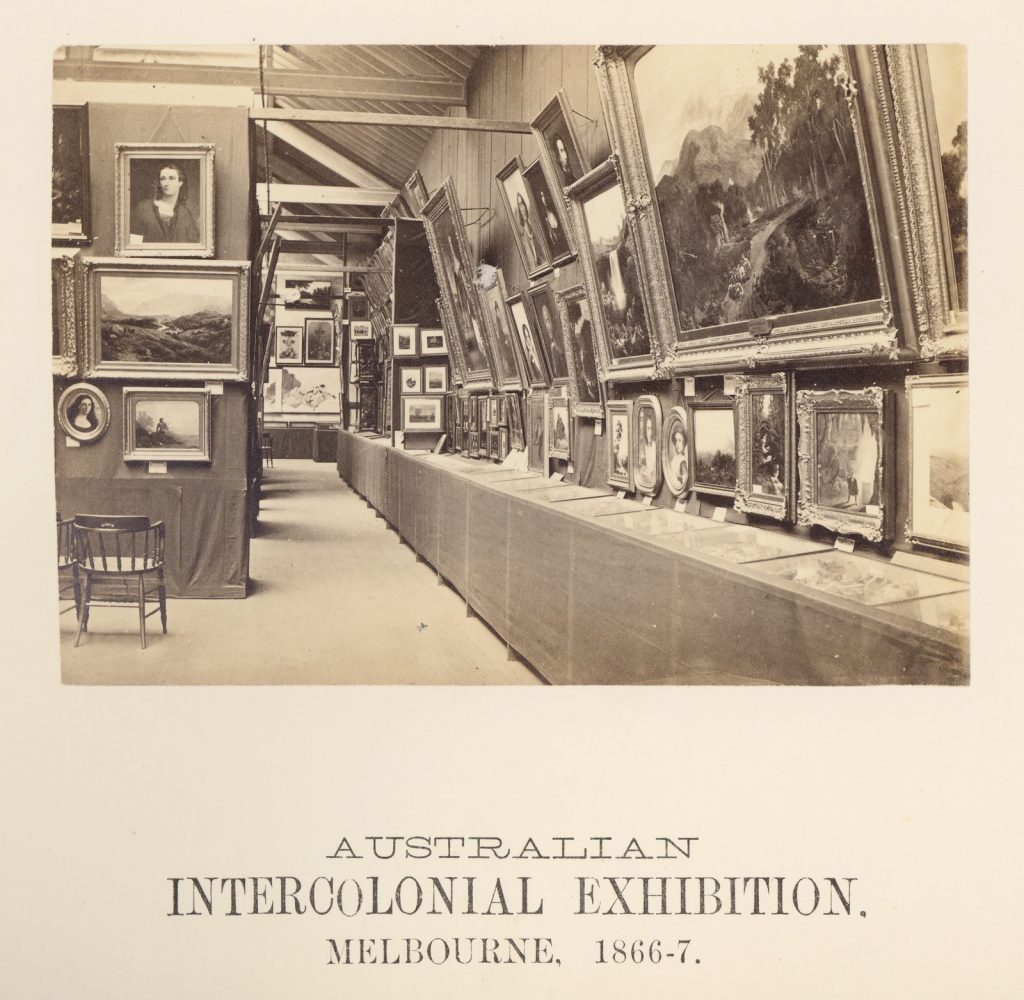
photograph by Thomas Ellis and Co., 1866-67, H30476

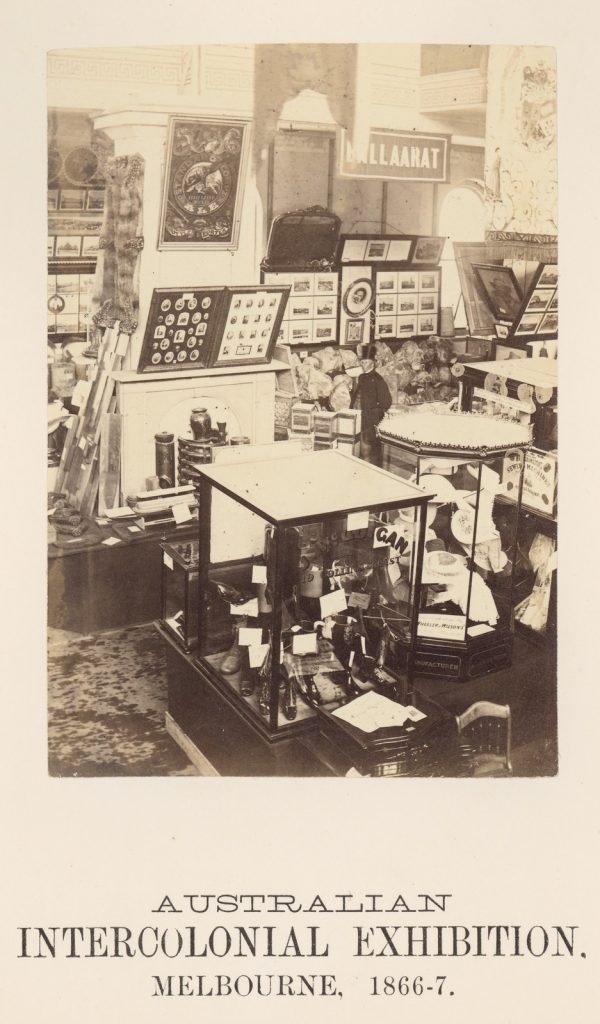


Biscuit pyramid; Piano. [National Library of Australia digitised item]
The Exhibition was deemed a great success – 268,000 visitors, from a Melbourne population of 139,916 and a Victorian population of 628,000 visited the exhibition halls over the spring and summer of 1866/67.

After the exhibition, the Industrial and Technological Museum occupied the Great Hall. Once McCoy Hall (now known as the now the Redmond Barry Reading Room) was completed, these collections moved there, alongside the mining and agricultural collections from University of Melbourne. The Museum remained onsite until opening, next to the Exhibition building in 2000. The National Gallery of Victoria remained on site in various buildings until the 1967/68 move to St Kilda Road. The Great Exhibition Hall, built in 1866, was declared unsafe in 1899 and demolished. The Rotunda remained until 1908 (in use as book storage). It was demolished to make way for the Domed Reading Room, opening in 1913.
Victoria was to host four more exhibitions this century, concluding with the grand international exhibitions in the summers of 1880/81 and 1888/89. The catalogues and newspaper reports give us a rich picture of the breadth of activities and interest of the population in attending.
Thousands of people have learned a vast deal more about Australasia during the past four months than they had acquired in years before; and, let me hope, have been strengthened in the feeling that if some dire calamity, which Heaven avert, should separate us from our parent country, we shall soon be in a position to supply ourselves with the necessaries and conveniences of life, as well as its luxuries and refinements. All honour, then, to the mind which gave practical effect to the idea of holding this Exhibition, to the Ministry that favourably entertained it, and to the Parliament of the country that granted such ample funds to carry it out; ay, and to the public both of this and our sister colonies for the lively interest and sympathy shown with the undertaking. 2
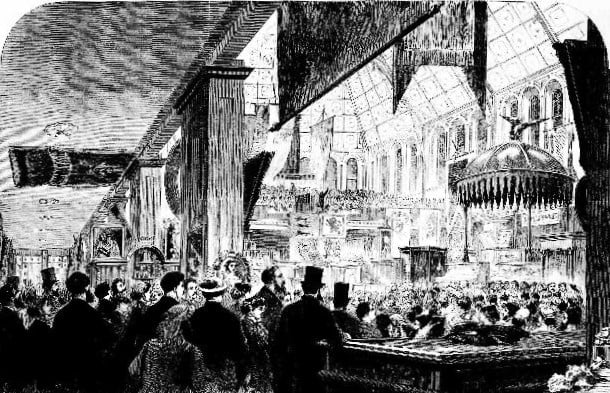
Further reading
- Melbourne’s first Exhibition Building
- Intercolonial and international exhibitions
- State Library Victoria – history
- World’s fairs – a global history of expositions
- Visions of colonial grandeur
References
- The Intercolonial Exhibition. The Age, 25 October 1866, p 5
- Close of the International Exhibition at Melbourne, Adelaide observer, 2 March 1867, p 6


